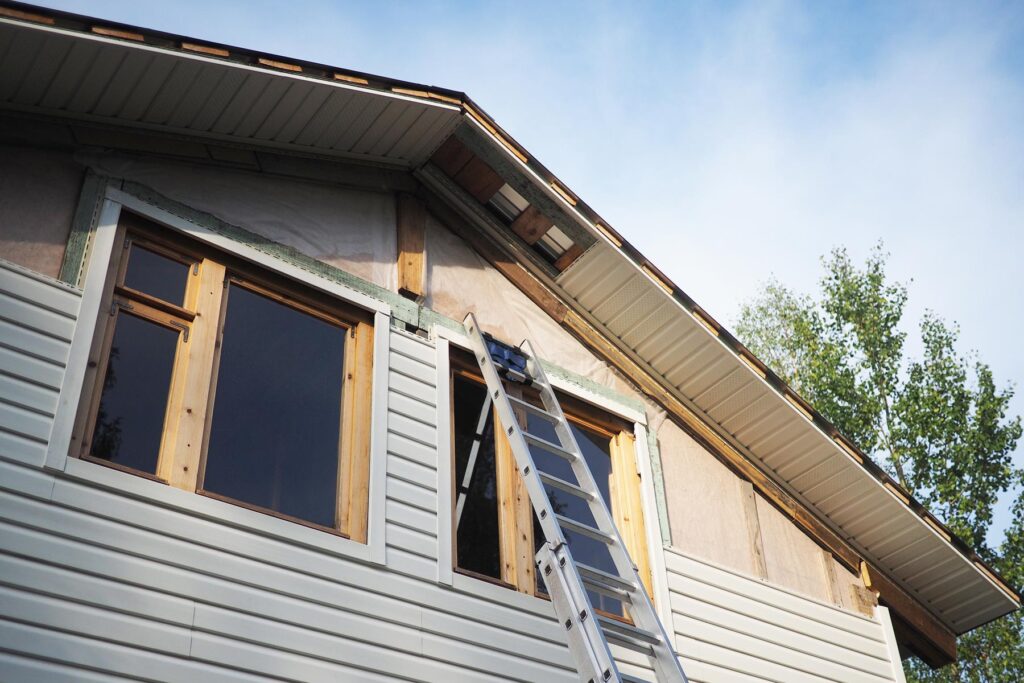Table of Contents
Roof And Siding Repairs For Severe Weather Damages In Indiana & Michigan (2023)
Indiana and Michigan are two states known for their beautiful landscapes, diverse communities, and unpredictable weather patterns. While residents of these states enjoy all four seasons, they also face severe weather, such as thunderstorms, tornadoes, hail, and heavy snowfall. Extreme weather conditions can cause significant damage to roofs and siding, leaving homeowners with the daunting task of repairs and maintenance. It makes you think about whether you should repair or replace your damaged roof. In this comprehensive guide, we will look at the various types of weather-related damage that occur in Indiana and Michigan, as well as provide expert advice on how to repair and protect your home effectively
Understanding Severe Weather Damages
Hail Damage
Hailstorms are common in the Midwest, especially in the spring and summer. These ice pellets, which can range in size from small pebbles to golf balls, can cause significant damage to your roofing materials and siding. Dented or cracked shingles, chipped paint, and broken siding panels are all common signs of hail damage.
Wind Damage
Strong winds are another common cause of roof and siding damage in Indiana and Michigan. Winds can lift shingles, blow siding off, or cause trees and debris to collide with your home. This can result in leaks, structural damage, and compromised insulation.
The Formation of an Ice Dam
Ice dams can form on the edges of your roof during the winter, preventing proper drainage of melting snow. Water may seep through the shingles and into your home, causing water damage, mold growth, and compromised insulation.
The Snow Load
Heavy snowfall can put a significant strain on your roof. If your roof is not structurally sound or well-maintained, it may collapse under the weight of snow, resulting in expensive repairs or even injury.
Water Leaks
Any type of severe weather can result in water leaks, which can cause extensive damage to your home’s interior. Water stains on your ceiling or walls, peeling paint, or warped wood indicate water intrusion.
Steps to Repair and Protect Your Home
Regular Inspections:
Conduct regular inspections of your roof and siding to detect any damage early on. Look for loose or missing shingles, damaged flashing, siding cracks, or any signs of water infiltration.
Emergency Repairs:
In the event of severe damage, take immediate action to prevent further harm. Cover any exposed areas with tarps or plastic sheeting to prevent water intrusion until professional repairs can be made.
Professional Inspection:
It is critical to have a professional roofing and siding contractor assess the extent of the damage. They can perform a thorough inspection and recommend the necessary repairs.
Roof and siding replacement:
Depending on the extent of the damage, you may need to replace the entire roof or siding. Modern materials are built to withstand harsh weather and provide better protection for your home.
Expert Roofing specializes in providing roof and siding replacement services professionally with free inspection.
Regular Maintenance:
Invest in regular maintenance after repairs or replacements to extend the life of your roofing and siding. Keep gutters clean, overhanging branches trimmed, and minor issues addressed as soon as possible.
Consult with professionals like Expert Roofing and Basement Waterproofing for free inspection and maintenance at affordable rates.
Insurance Claims:
If your home is insured, contact your insurance company to discuss weather-related damage coverage. Keep detailed records of all repair and replacement costs and thoroughly document the damage.
Process of Roof Repair
a.Roof Repairs
Patching Minor Shingle Damage:
When you notice minor shingle damage, such as a few loose or cracked shingles, you can address it yourself with the following steps:
- Gather the necessary tools: You’ll need roofing cement, a putty knife, and replacement shingles that match your existing ones.
- Carefully lift the damaged shingle and apply roofing cement underneath it.
- Press the shingle down firmly and secure it with roofing nails.
- Apply more roofing cement on top to seal the edges.
This temporary fix can prevent further damage until you can arrange for a more comprehensive repair.
Professional Inspection for Extensive Damage:
For more severe roof damage, such as extensive shingle loss, structural damage, or leaks, it’s essential to seek professional help:
- Contact a licensed roofing contractor to perform a thorough inspection.
- The contractor will assess the extent of the damage and recommend the necessary repairs or replacements.
- Follow their advice and schedule the repairs promptly to prevent further issues.
Replacing Damaged or Missing Shingles:
Timely replacement of damaged or missing shingles is crucial to maintain the integrity of your roof:
- Purchase replacement shingles that match your existing ones in color, style, and material.
- Carefully remove the damaged shingles, taking care not to damage adjacent ones.
- Slide the new shingle into place and secure it with roofing nails.
- Seal the edges with roofing cement to ensure a watertight fit.
Repairing Leaks and Water Damage:
Roof leaks and water damage can cause significant structural issues if left unaddressed:
- Identify the source of the leak and mark it for repair.
- Use roofing cement or a patch kit designed for roof repairs to seal the leak.
- Address any water damage to the interior of your home by replacing damaged insulation, drywall, or ceiling materials.
b. Siding Repairs
Patching Small Cracks or Holes:
Minor cracks or holes in your siding can be addressed with simple DIY steps:
- Clean the damaged area and remove any loose debris.
- Apply caulk or putty to fill the crack or hole, smoothing it out with a putty knife.
- Allow it to dry completely before painting over the repaired area.
Replacing Severely Damaged Siding:
When sections of your siding are extensively damaged or missing, replacement may be necessary:
- Identify the damaged sections and carefully remove them, starting at the top and working your way down.
- Purchase matching siding materials to replace the damaged sections.
- Install the new siding, ensuring it aligns properly with the existing pieces.
- Secure the new siding in place with nails or screws.
Repainting or Resealing:
- Regular maintenance of your siding is essential to protect it from moisture and further damage:
- Clean your siding thoroughly to remove dirt and debris.
- Repaint or reseal the siding to maintain its protective barrier against the elements.
- Follow the manufacturer’s guidelines for paint or sealant application
Conclusion
Living in Indiana and Michigan means being exposed to several severe weather conditions. It is critical to be proactive in inspecting, repairing, and maintaining your roof and siding to protect your home and family. Remember that prompt action can prevent minor issues from becoming major issues, and professional assistance is invaluable in ensuring the exterior of your home’s longevity. Stay safe, and prepared, and enjoy the beauty of these two great states while your house remains a haven in any weather. Expert Roofing and Basement Waterproofing offers comprehensive roofing services with exceptional discount coupons. To learn more visit our website: expertroofingwaterproofing.com
What types of severe weather damage can affect roofs and siding in Indiana and Michigan?
How can I tell if my roof or siding has been damaged by severe weather?
Why should I choose professional repair services for severe weather damage?


